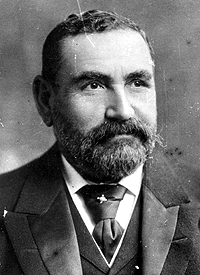John See: Difference between revisions
mNo edit summary |
No edit summary |
||
| Line 88: | Line 88: | ||
[[Category:1844 births]] |
[[Category:1844 births]] |
||
[[Category:1907 deaths]] |
[[Category:1907 deaths]] |
||
[[Category:Leaders of political parties in Australia]] |
|||
[[Category:Premiers of New South Wales]] |
[[Category:Premiers of New South Wales]] |
||
[[Category:Members of the New South Wales Legislative Assembly]] |
[[Category:Members of the New South Wales Legislative Assembly]] |
||
Revision as of 09:10, 12 July 2009
Sir John See | |
|---|---|
 | |
| 14th Premier of New South Wales | |
| In office 28 March 1901 – 14 June 1904 | |
| Preceded by | William Lyne |
| Succeeded by | Thomas Waddell |
| Constituency | Grafton |
| Personal details | |
| Born | 14 October 1844 Yelling, Huntingdonshire, England, UK |
| Died | 31 January 1907 (aged 62) Randwick, Sydney, New South Wales, Australia |
| Spouse | Charlotte Mary Matthews (1876–1904) |
Sir John See, KCMG (14 October 1844 – 31 January 1907) was a member of the New South Wales Legislature from 26 November 1880 to 15 June 1901, and was then Premier of New South Wales from 1901 to 1904.
See was a self-made man of strong character, an excellent business man and a sound politician. He was a good friend, much esteemed on both sides of the house, for Labour politicians remembered that during his administration the establishment of the State clothing factory had a great influence in abolishing sweating, and that women's suffrage was also brought in in his time.[1]
Early life
See was the son of Joseph See, a farm-labourer, and his wife Mary Ann, and was born in Yelling, Huntingdon, England. The Parish Records of his baptism show that he was christened "See or Seekings" and that his parents/grandparents etc. used both surnames. He was brought to Australia in 1852 by his parents who settled on the Hunter River in New South Wales. On the family move to Australia they no longer used the "Seekings" surname. After three years at school See worked on the family farm, but in 1863 took up land with a brother on the Clarence River. In 1865, following disastrous floods, he went to Sydney and began business as a produce dealer. This business became very flourishing under the name of John See and Company. He also became a partner in a small coastal shipping company, Nipper and See, which was afterwards floated into a company, as the North Coast Steam Navigation Company. See was a shrewd investor and became very well known in business circles in Sydney. In 1876, he married Charlotte Mary Matthews. See built a mansion in the Sydney suburb of Randwick and served on Randwick Council as alderman and mayor. He became a director of several well-known companies, a trustee of the Savings Bank of New South Wales, and president of the Royal Agricultural Society. In 1891, his shipping line had 14 steamships when it merged with another line to form the North Coast Steam Navigation Co. Ltd and he remained its joint managing director until his death. He also acquired property throughout the state.[1][2]
Political career
See entered politics in 1880 as member for Grafton[3] and remained its member until he retired in 1904. In October 1885 he joined the George Dibbs government as Postmaster-General, but Dibbs was defeated before the end of the year. See was not in office again until October 1891 when he became for nearly three years Colonial Treasurer in the third Dibbs ministry. He was in charge of the bill which brought in the first protectionist tariff in New South Wales. The whole of his period as Treasurer was marked by much financial stress throughout Australia. From August 1894 until September 1899 Reid was in power, but when William Lyne came in, See was his Colonial Secretary.
On Lyne transferring to federal politics in March 1901, See became Premier and held office until 1904. His government passed the Industrial Arbitration Act in 1901 and the Female Suffrage Act in 1902. On the other hand, poor economic conditions and drought forced the government to abandon an ambitious public works program.[2] Failing health and the death of his wife in March 1904 compelled him to retire in June. He accepted a seat in the Legislative Council, but was unable afterwards to exercise much influence in politics.
See died at Randwick, Sydney on 31 January 1907. He fathered ten children and was survived by four daughters and three sons.[1]
Honours
See was created Knight Commander of the Order of St Michael and St George in 1902.[1]. The See Park in Grafton is named after him.
References
- ^ a b c d Serle, Percival. "See, Sir John (1844–1907)". Dictionary of Australian Biography. Project Gutenberg Australia. Retrieved 7 April 2007.
- ^ a b Henry, Keith. "See, Sir John (1845–1907)". Australian Dictionary of Biography. Australian National University. Retrieved 7 April 2007.
- ^ "Sir John See (1845–1907)". Members of Parliament. Parliament of New South Wales. Retrieved 7 April 2007.
